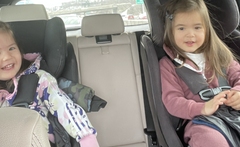Is your little one starting to show signs of wanting to be more verbal with you? If your child is at a stage where they're imitating sounds or trying to use more words to communicate with you, then please read on!
Even if you're not quite there yet with your little one, I've got some helpful tips on how to encourage your toddler to begin building solid verbal communication skills. In this post I will go over what is known as Communication Temptations. Communication Temptations are basically ways to tempt your child to communicate or talk. In other words, it gives them a reason to talk.
With over 5 years of experience as a speech therapy associate and behaviour therapist, I want to share some tips I've learned along the way to help encourage your young toddler to talk!
1. The importance of context

Sometimes it’s tempting to try to get your child to say words or repeat after us randomly and out of context, usually because it’s convenient for us or we want to show off their newly learned words to friends and family.
You might be excited to show off your child's new verbal skills, and immediately when in front of someone new, you tell your child to say "elephant" meanwhile your child is in the middle of playing with blocks, not elephants.
Practicing words in context just makes more sense and gives your child more reason to talk. Even though your child might comply and repeat “elephant”, practicing words in context will better help with solidifying learning and making associations for vocabulary building.
If you’re practicing animal words with your child, do it while playing with actual animal toys. You can even change up the context and practice some more at snack time with animal crackers!
2. Motivation is key

Motivation is key, and learning to talk and use words as a new skill is really hard for emergent speakers! So if it’s not going to be fun, why would they want to do it?
Use what motivates your child (hence the “temptation” part of Communication Temptation) to your advantage. Is your child motivated by food? Practice words during meal and snack times! Does your child love trucks or animals? Practice during playtime!
When you make learning fun and enjoyable, it will motivate your child to continue learning and talking!
3. Use the bit-by-bit strategy

Using the bit-by-bit strategy is a super effective way to create lots of opportunities to practice your target words.
For example, if you’re practicing food vocabulary or function words like “open” and “more”, you can use the bit-by-bit strategy during snack time. Instead of giving your child their snack all at once, offer it to them bit-by-bit. This will give your little one a reason to keep on asking for more snacks using the target words.
During playtime, you can do something similar by making desired toys visible but inaccessible. For example, put a toy car in a clear container that your child can’t open. Your child will now need to ask you for help, the perfect opportunity to practice words like “help”, “open”, and “car”. Continue the play and pretend to drive the car up high onto a shelf. Another opportunity for Little One to practice the new words and ask for your help!
Don’t Forget!
At the end of the day, the most important thing to remember is to make learning FUN. Keep in mind that you don’t want to push your child too hard and make it frustrating for them. For example, during snack time, you don’t have to use the bit-by-bit strategy for the entire meal, just enough to practice a few times or as much as your child will tolerate.
Keep it fun, and happy talking!
➡️ Which words or phrases are you practicing with your little one? Let us know in the comment section below!
About the author:
Samantha Lai is Jenny & Andy’s Marketing Coordinator. Before she joined Jenny & Andy, she was a speech therapy associate and behaviour therapist who spent 5 years working with young toddlers with autism and other exceptionalities and their families.
Her therapy sessions required her to work collaboratively with Speech-Language Pathologists, Board Certified Behaviour Therapists, Occupational Therapists, Teachers, and Registered Early Childhood Educators.



